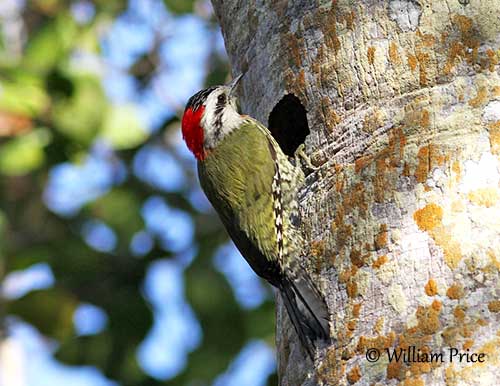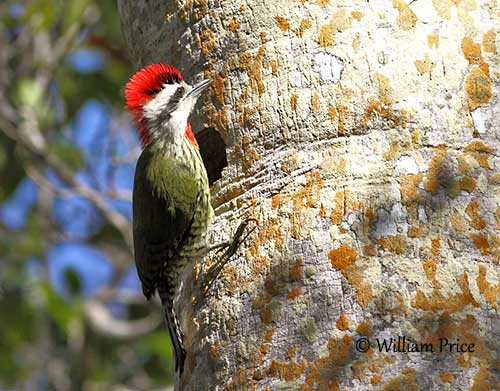
Fr: Pic poignardé
Ang: Cuban Green Woodpecker
All: Blutfleckspecht
Esp: Carpintero Tajá
Ita: Picchio di Cuba
Nd: Cubaanse Groene Specht
Sd: kubagrönspett
Photographer:
William Price
PBase-tereksandpiper & Flickr William Price
Text by Nicole Bouglouan
Sources :
HANDBOOK OF THE BIRDS OF THE WORLD Vol. 7 by Josep del Hoyo-Andrew Elliott-Jordi Sargatal – Lynx Edicions – ISBN: 8487334377
BIRDS OF THE WEST INDIES – by Herbert Raffaele, Kristin Williams et Tracy Pedersen – Helm – ISBN: 9780713649055
Neotropical Birds – Cornell Lab of Ornithology
Wikipedia, the free encyclopaedia
Wikipedia, la enciclopedia libre
Cuba Explorer - Birds of Cuba - Endemic and near endemic birds of Cuba
Cuban Green Woodecker
Xiphidiopicus percussus
Piciformes Order – Pididae Family
INTRODUCTION:
The Cuban Green Woodpecker is included in the tribe Melanerpini within the family Picidae. This monotypic species is the only member of the genus Xiphidiopicus. It is endemic to Cuba where it is resident.
It frequents both wet and dry forests, pine forest and coastal vegetation. It is common and widespread on this large island.
The Cuban Green Woodpecker had formerly six subspecies, but today, only two are recognized. The races “monticola” and “cocoensis” are now synonyms of the nominate race, whereas the races “gloriae” and “marthae” are synonyms of the subspecies “insulaepinorum”.

DESCRIPTION OF THE BIRD:
Biometrics:
Length: 21-25 cm
Weight: 45-97 g
The Cuban Green Woodpecker adult male has green upperparts with some yellow or grey wash. The rump is yellower and shows some pale and dark bars, and dark narrow streaks. The uppertail-coverts are paler green with dark barring. The uppertail is dark brown with tinged grey centre and paler brown bars on outer rectrices.
On the upperwing, primaries and secondaries are dark brown with broad white barring. Bars are mostly green on the outer webs of secondaries.
The underparts are yellow with black streaks on breast, and sometimes orange tinge on belly. Flanks and vent are whitish with heavy black barring. The undertail is brown with barred sides. The underwing is barred brown and whitish and the coverts are tinged greenish.
On the head, crown, nape, hindneck and crest are red, with some black bases to the feathers, mainly on forecrown. The face is white. We can see a black stripe from the rear of the eye to the side of the hindneck. The chin is black. Throat and centre of upper breast have red-tipped feathers forming a bright red patch.
The short, straight bill is bluish-black, darker towards the tip. The eyes are dark brown, surrounded by grey eyering. Legs and feet are greyish-olive.
The female is significantly smaller than male. She has black crown finely streaked white. The underparts show heavier barring than on male.
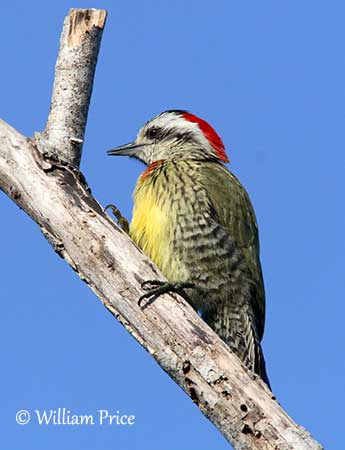
The juvenile is duller and more heavily barred, with narrow dark bars on the upperparts, more conspicuous on rump. It may have some red on the mantle. The tail is barred. On the underparts, the throat is brownish-black and the belly’s patch is smaller, orange to red-orange. The head pattern is similar to adults but blacker on the forecrown, becoming soon white-streaked on young female’s head.
SUBSPECIES AND RANGE:
The Cuban Green Woodpecker has two subspecies.
X.p. percussus is found on Cuba and Sabana and Camagüey Archipelago.
X.p. insulaepinorum is found on I of Pines, Cantiles Keys and Archipelago Jardines de la Reina.
This one is smaller and paler than nominate, with smaller red throat patch. The belly is paler yellow and the tail is fully barred.
HABITAT:
The Cuban Green Woodpecker frequents wet and dry forests and other forest types such as mangroves, open woodland with palms, and pine forest. This species is visible in both highland and lowland forests.
CALLS AND SONGS: SOUNDS BY XENO-CANTO
The Cuban Green Woodpecker’s call is a short, harsh “jorr, jorr, jorr” or higher-pitched “eh, eh, eh”. Single or double notes are occasionally uttered.
It may sometimes produce a slurred, two-note call “ta-ha” similar to that of the Yellow-bellied Sapsucker (Sphyrapicus varius). It is sometimes highly vocal when protecting nest and chicks from intruder.
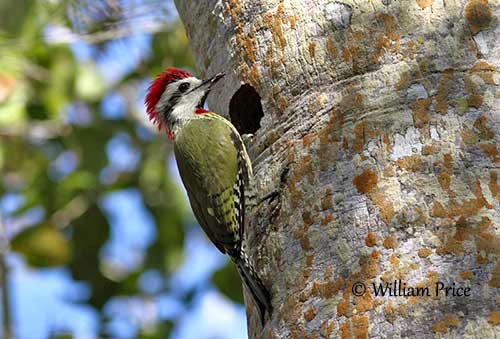
BEHAVIOUR IN THE WILD:
The Cuban Green Woodpecker feeds primarily on large insects, and also takes fruits and small frogs. It may sometimes take the eggs of other birds such as Ardeidae nesting in mangroves.
But it also feeds on nectar from flowers, and especially Cordia Sebestena. It inserts its bill into the floral tube to drink the nectar during one to several seconds, while perched on the plant itself or on nearby branch to reach the flowers. By drinking nectar in this way, the bill touches anthers and stigma inside the floral tube, and the bird acts as pollinator.
The Cuban Green Woodpecker usually forages in pairs or small groups of 3-5 individuals. It forages on dead branches, by pecking for insects under the bark or in bark crevices.
As the male is larger than the female, they use different ways to exploit different food sources.
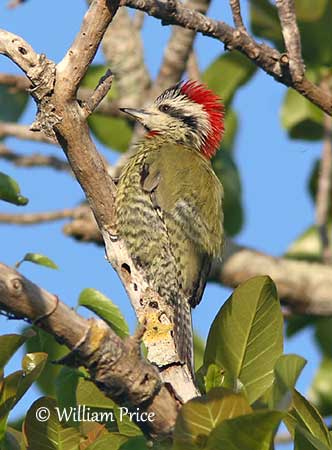
The Cuban Green Woodpecker advertises its presence with drumming and vocal signals. It is territorial during the breeding season. It pursues intruders approaching the nest while calling loudly and flicking the wings. Aggressive encounters are frequent at the beginning of the breeding season.
The courtship displays of this species are unknown, but usually, woodpeckers perform flutter-aerial-display including a gliding flight with wings held well above the back, accompanied by calls. Courtship feeding by male to female probably occurs too. They are monogamous.
The Cuban Green Woodpecker is resident on Cuba, but it can be seen sometimes on Hispaniola after storms.
Like all woodpeckers, its flight is undulating.
REPRODUCTION OF THIS SPECIES:
The breeding season takes place between February and August, with peak in May-June associated with rains.
The Cuban Green Woodpecker nests in natural cavities excavated in live or dead tree, often 4-5 metres above the ground. The male usually does most of nest-hole excavation, and takes part to the nesting duties with a relatively high contribution.
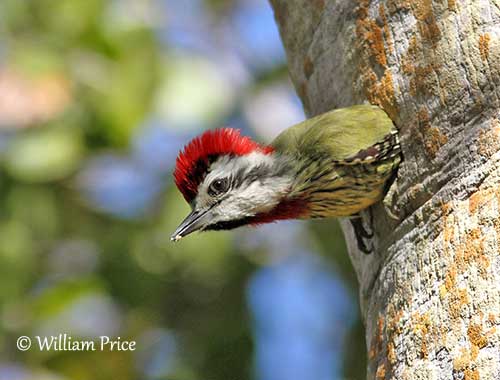
The female lays 3-4 white eggs and both adults share the incubation and feed the chicks. More information is currently lacking, but usually, woodpeckers heave fairly short incubation period of 9 to 14 days. The chicks are completely naked at hatching and remain in the nest for a relatively long time, about 3-4 weeks. They are sexually mature in the first year of life.
PROTECTION / THREATS / STATUS:
The Cuban Green Woodpecker is common throughout its range, and can be seen in a wide variety of wooded habitats and at all elevations.
The population is suspected to be stable and currently, the Cuban Green Woodpecker is evaluated as Least Concern.
